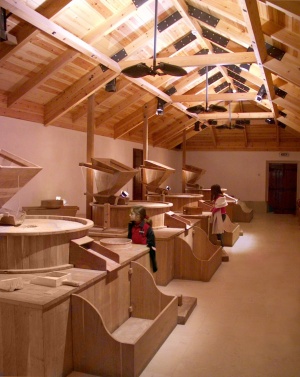
PT: Funcionamento do Moinho do Cais
Quando a maré sobe, entra pelas comportas na caldeira e enche-a como se o moinho ali não estivesse. A caldeira fica cheia na preia-mar.
O moinho não pode laborar nesta fase por duas razões: primeiro, a maré submerge os dois lados impedindo qualquer fluxo de água e segundo o rodízio (motor do moinho) encontra-se debaixo de água, sendo prejudicado qualquer movimento giratório. Quando a maré começa a descer as comportas da caldeira são fechadas, mantendo o nível da água atingido na maré alta (o qual é variável de dia para dia). A amplitude das marés no estuário do Tejo oscila entre 1,25m e 4,25m.
O funcionamento do moinho inicia-se quando a maré diminui a um ponto abaixo do rodízio. Quando isto acontece, o pejadouro é ligeiramente aliviado e o jacto de água proveniente da caldeira atravessa o edificio e atinge as penas no rodízio, fazendo-o girar.
A laboração decorre durante o período de baixa-mar, até que a subida da maré alcança novamente a base do rodízio e começa a interferir com o seu movimento, contrariando a rotação.

EN: Operation of the Mill Wharf
When the tide rises, walk through the gates into the boiler and fill it as if the mill were not there. The boiler is filled at high tide the sea.
The mill can not laboring at this stage for two reasons: first, the tide immerses both sides preventing any flow of water and the second caster (motor mill) is under water, any rotary movement being impaired. When the flow starts to descend the gates of the boiler are closed while maintaining the water level at high tide reached (which is variable from day to day). The tidal range in the Tagus estuary varies between 1.25 m and 4.25 m.
The operation of the mill is initiated when the flow decreases below a point of rotation. When this happens, the pejadouro is slightly relieved and the jet of water from the boiler through the building and reach the feathers on the caster, causing it to rotate.
The work takes place during the period of low tide, until the rising tide reaches again the basis of rotation and begins to interfere with its movement, against rotation.

Moinho de Maré do Cais
Moinhos
Horário Visita Livre:
Terça a Sexta-Feira das 13h00 às 17h30
Sábados e Domingos das 14h30 às 17h30
Horário Visita Guiada:
Marcação prévia para o número
212 32 78 45
Fontes: C. M. Montijo / TIMS



